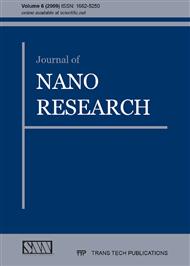[1]
Kurtus, Ron. -Resistive Force of Friction. ‖ School for Champions. (1-31-05). <http: /www. school-for-champions/science/friction. htm>.
Google Scholar
[2]
Kunzia, Robert. -Why Does It Stick? - the hypothesis that push-on adhesives use bubbles to create vacuum. ‖ Discover. (2-17-05) <http: /www. findarticles. com/p/articles/mi_m1511/is_7_20/ai_55030830>.
Google Scholar
[3]
Mechler, A., J. Kokavecz, P. Heszler, R. Lal. Surface energy maps of nanostructures: atomic force microscopy and numerical simulation study. Appl Phys Lett 82: 3740-3742, (2003).
DOI: 10.1063/1.1577392
Google Scholar
[4]
Yang, S., Zhang, H., Hsu, S. M., (2007) Correction of Random Surface Roughness on Colloidal Probes in Measuring Adhesion. Langmuir, 23, 1195-1202.
DOI: 10.1021/la0622828
Google Scholar
[5]
Hansma, P.K., B. Drake, D. Grigg, C. Prater, G. Gurley, V. Elings, S. Feinstein, R. Lal. A new, optical-lever based atomic force microscope. J. Appl. Phys. 76: 796-799, 1994b.
DOI: 10.1063/1.357751
Google Scholar
[6]
Rugar, D.; Hansma, P. -Atomic force microscopy‖, Phys. Today 43(10), 23-30 (1990).
DOI: 10.1063/1.881238
Google Scholar
[7]
Almqvist, N., Bhatia, R., S. Banerjee, G. Primbs, N. Desai, R. Lal. (2004).
Google Scholar
[8]
Radmacher M, Cleveland JP, Fritz M, Hansma HG, Hansma PK., Mapping interaction forces with the atomic force microscope. Biophys J. 1994 Jun; 66(6): 2159-65.
DOI: 10.1016/s0006-3495(94)81011-2
Google Scholar
[9]
Abu-Lail, L., Yataoliu, Arzuatabek, Camesano, T., (2007) Quantifying the Adhesion and Interaction Forces Between Pseudomonas aeruginosa and Natural Organic Matter. Environ. Sci. Technol., 41, 8031-8037.
DOI: 10.1021/es071047o
Google Scholar
[10]
Li, X., Logan, B. E., (2004) Analysis of Bacterial Adhesion Using a Gradient Force Analysis Method and Colloid Probe Atomic Force Microscopy. Langmuir, 20, 8817-8822.
DOI: 10.1021/la0488203
Google Scholar
[11]
Parbhu, A., W. Bryson, R. Lal. Disulfide bonds in the outer layer of keratin fibers confer higher mechanical rigidity: correlative nano-indentation and elasticity measurement with an AFM. Biochemistry 38: 11755-11761, (1999).
DOI: 10.1021/bi990746d
Google Scholar
[12]
Yang, L., Sheldon, B. W., Webster, T. J. (2008) Orthopedic nano diamond coatings: Control of surface properties and their impact on osteoblast adhesion and proliferation. Journal of Biomedical Materials Research Part A.
DOI: 10.1002/jbm.a.32227
Google Scholar
[13]
Quist, A.P., Rhee, S.K., Lin, H, Lal, R. Physiological role of gap-junctional hemichannels. Extracellular calcium-dependent isosmotic volume regulation J. Cell Biol. 148: 106374, 2000. Acknowledgements The work was performed in the laboratory of Dr. Ratnesh Lal at the Neuroscience Research Institute, University of California at Santa Barbara. Due to the potential repair cost, in the event of any damage, atomic force microscopy (AFM) images and force curves were obtained by Dr. Arjan Quist. I thank Dr. Quist for teaching me the techniques of AFM and advance light microscopy imaging and for giving proper guidance and support for the project. I also thank Dr Paul Hansma for proper guidance, encouragement and critical improvement of the presentation and my understanding of the subject matter.
Google Scholar


